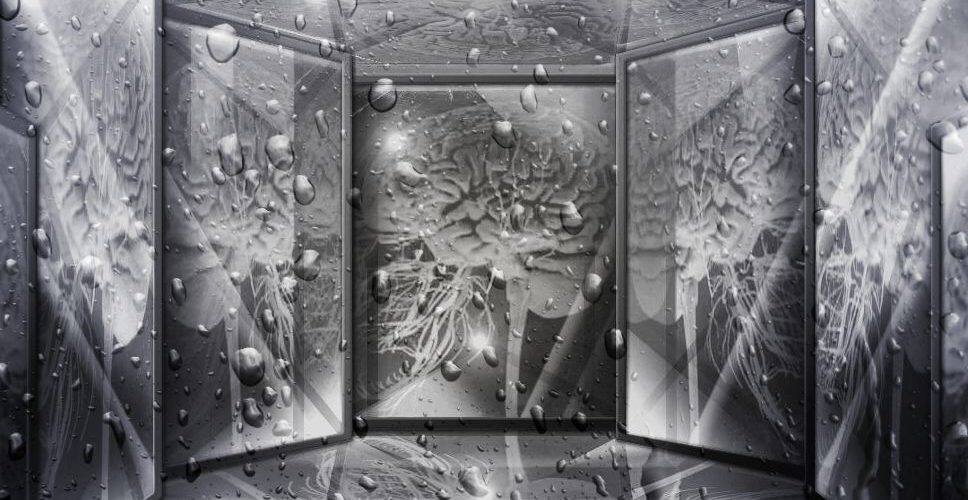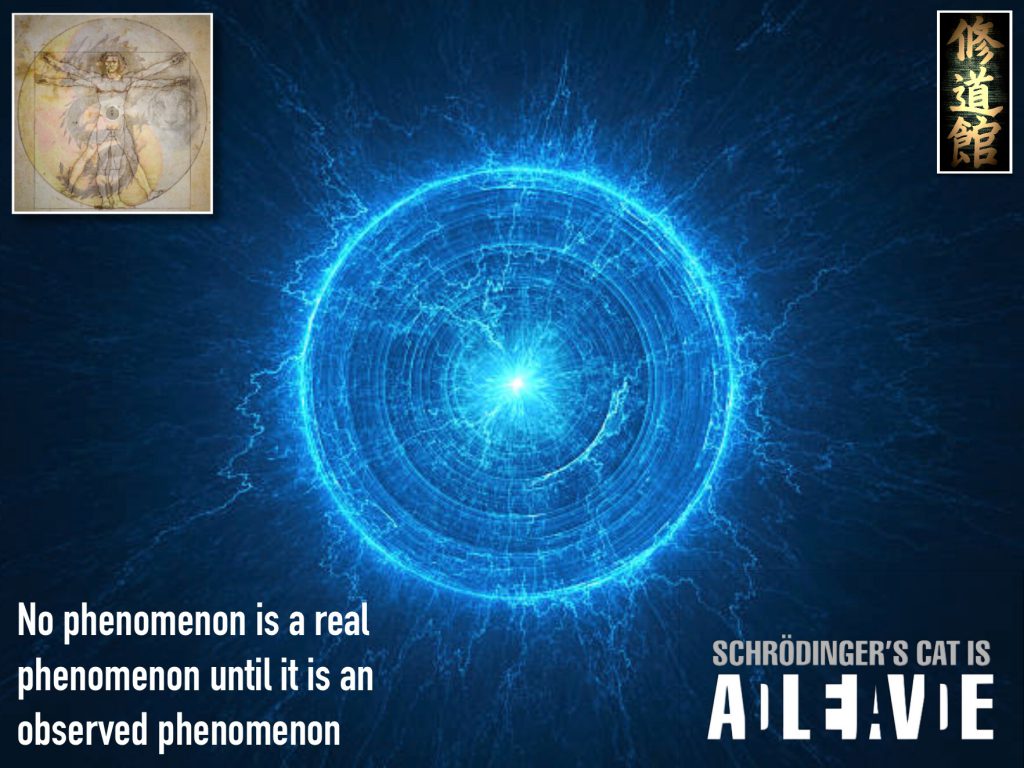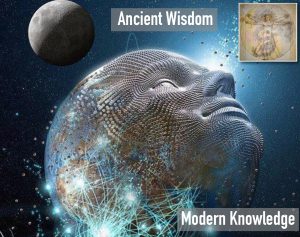We always talk about “inner pictures” and “ideas”, but we have not yet dealt with where these inner pictures arise and especially what this process of creation means.
Among physicists there is the clever question “Does a falling tree make a sound when no one is listening?”

What happens when a tree falls? It displaces air. What is displaced air? Pressure and density fluctuations in the medium “air”, i.e. a mechanical vibration.
A mechanical oscillation is therefore initially nothing more than moving molecules in a medium. The falling tree produces a compression energy which is converted into kinetic energy, which causes molecules to move. But that is not noise!
Wait! some will say now. But my ears can convert these movements into an electrochemical impulse and transmit them via nerves to my hearing centre, which leads to me hearing the tree! That’s right. The ears do that. They catch kinetic energy in the medium air and convert a certain frequency range into nerve impulses. Frequencies from 16 Hz to 20 kHz can be converted in this way. All other frequencies, below or above, cannot be converted by the human ear. However, a bat’s ear or a whale’s ear could do this.
Now what does this mean for the sound of the falling tree? Well, first we have moving molecules in the air, now that they have reached the ear, we have nerve impulses, that is, electrical activity in the brain. Now is that sound? To do that, we have to look at which nerves were just stimulated:
First of all the auditory nerve. But the rest of the brain doesn’t even realize that at first. The auditory nerve transmits its excitation to the brain stem, which sends the excitation to the midbrain where it is compared with other excitations and then to the cerebral cortex where our mind perceives the excitation of the nerve cells in the temporal lobe and we become aware of this excitation as “noise”.
What does that mean now? It means that a “sound” is only produced at the moment when the excitation of nerve cells in the cerebral cortex is registered by our mind and it makes us aware of this excitation. Before this happens, we have mechanical and electrical stimuli that must first be processed in order for a sound to be produced. What are they processed by? By different parts of our brain.
So a falling tree does not yet make any noise! The noise is created in our mind.
What about the visual perception of the tree itself? Is the tree there?
First of all, the atoms that make up the tree absorb a certain wavelength of the light incident on them, while reflecting other wavelengths. So the atoms reflect certain electromagnetic waves. But these waves are not a tree. So what happens to the waves?
They hit our eyes and are directed to the retina. There, light of a certain wavelength irritates a certain type of cell, which in turn generates an electrical nerve impulse. There are, for different wavelengths, different types of cells on the retina. We humans can therefore convert light in a wavelength of 380 nm to 750 nm into electrical nerve impulses. Any other electromagnetic radiation cannot be perceived by our eyes.
So let us note: The atoms reflect electromagnetic radiation of a certain wavelength, which is converted into nerve impulses in our eyes in a range of 380-750 nm. These nerve impulses are transmitted to the midbrain where they excite further nerve tracts and are matched with other excitations until they reach our cerebral cortex in the area of the occipital lobe and excite the cells there. Only this excitation is then perceived by our mind as a “tree”.

So we got the same thing as the sound. The “tree” is only created at the moment when the excitation of certain nerve cells in the occipital lobe is registered by our mind and made conscious. Before that, the tree is only an electromagnetic radiation, respectively it is atoms that reflect the incoming electromagnetic radiation, respectively it absorbs parts of it.
Can we touch those atoms? What happens if we touch the tree? The atoms of our skin are repelled by the atoms of the tree, the stronger they are, the closer they get. So we sense when atoms of the skin are repelled by the atoms of the tree? No. The skin cells cannot transmit this information, they only deform and this creates a mechanical stimulus that is transmitted. Only when this deformation meets special cells in the skin (so-called mechanoreceptors), the repulsion of the atoms, i.e. the mechanical deformation, turns into a nerve impulse. This nerve impulse becomes what? Exactly. Transmitted to the spinal cord, from there to the subconscious part of the brain where it is processed and stimulates other nerves, until it finally reaches the cerebral cortex and what happens?
Right. The mind recognizes the excitation of these cells and from the excitation we are made aware of an image. This information, e.g. rough surface, i.e. bark, is compared with the visual information and we recognize an overall picture.
Our reality is created by excitation of cells of the cerebral cortex, which is registered by our mind! Everything we perceive is generated within us. We give a name to certain patterns, or rather our mind gives a name to these patterns. Does this mean that an excitation pattern of the cerebral cortex is still not a tree, or a sound, or a bark? Exactly.
Please let this paragraph sink in peace once again.
A sound or an object is only created when we have seen/heard/felt this excitation pattern before and we have given it a name. Otherwise it is only a stimulus at first. Our mind gives this stimulus a name. This is called “learning”.
Babies are frightened by noises, unknown faces etc. because they have no experience with these stimuli. Only when they return and the baby learns that they are not dangerous does it no longer get frightened or is happy. The stimulus of the cerebral cortex was stored in the memory and combined with other “inner states” (combined excitation patterns), which immediately followed these or existed in parallel. In the course of its development, our baby will then begin to speak and combine the stimulus of the cerebral cortex with a sound/word. Thus, the visual excitation pattern that the tree produces on the cerebral cortex becomes the “tree”. The stimulus is “named”.
Everything we perceive is permanently compared with stored perceptions and patterns. Only through this does our reality emerge. A tree is only a tree when I can identify it as a tree. Before that it is a special excitation pattern in my cerebral cortex, which I perceive consciously because it is directed to my mind.
Reality is created in my head. My reality looks different from that of a fly (which perceives time much more slowly, but that’s a subject for another article) or the reality of a shark, whale or bat. These animals can perceive a completely different spectrum of electromagnetic radiation and also a completely different frequency range of sounds. Their reality differs from ours.
Our sense organs are the gateway to our consciousness. They create our image of reality. “Inner images” are combined excitation patterns from stored perceptions. We use them permanently to create our reality and to find our way in the world. You can let them become more and more complex and continue to work with these images in your mind. This happens while you read this text and also while I write it.
A letter is nothing more than a combined perception that I have stored in my memory. I can use this perception according to certain rules, which I have also learned as “abstract perception”, and combine it with other stored perceptions. This is how language and writing are created.
So our mind perceives our environment through stimuli, stores them and constantly balances them. It creates an “outer map”, so to speak, names objects, analyses objects, interacts with objects.
On the other hand, our mind is also constantly receiving “status messages” from its body and “evaluated” by deeper brain structures. On the one hand this can be muscle tension, hunger, pain etc., but also fear, hunger, love, joy etc.

Feelings are much older than our understanding. Animals react through feelings/drives. You could say they were the first mechanisms our brain used to control our body. Little energy causes “hunger”, which causes aggression. This for increased attention, which in turn for finding food and killing. Food leads to energy, energy leads to reward and reward makes you happy. There is little with “thinking”, more with feeling.
Our body has a control centre with the brain and this has to “control” it somehow, “how do I tell my body”. Emotions have been an important step.
Now, of course, it has made sense to suppress the emotions, or the impulses for action that arise from them. To mate with the female when the pack leader is standing next to me is not very useful, that gives trouble. Now the “mind” comes into play. Originally a control instance of the emotions, it has developed over time and species and got “a life of its own”. The more it was able to intervene in our “programs”, the more effectively it was able to provide for the preservation of our species. An effective mind has obviously been an evolutionary advantage not to be underestimated. Not only did it control emotions, but the more complex it became, the more it was able to make planning possible.
Let’s take a closer look at the emotions. You can “override” the mind, or you can talk to it all the time. So the mind not only reacts to stimuli on its cerebral cortex, but also constantly hears babble from its emotional centers.
These emotional centers in turn also react to external stimuli through the “unconscious” connection of nerve impulses before they reach the cerebral cortex. This unconscious wiring causes the body to react (muscle tension, reflexes, etc.) and generate emotions before (or during) the stimulus reaches the cerebral cortex.
So we always have a double interpretation of the external stimuli. The awareness through the mind and the “unconscious” through the deeper lying centres. Unconsciously this processing is not complete, because it is reported to the mind in form of emotions/drives.
So the mind is fed with two “interpretations” of the outside world. That which arrives at the cerebral cortex and that which arrives at Him from unconscious processing, in the form of emotions. Sometimes one is louder, sometimes the other. He tries to regulate the volume almost permanently, only sometimes the emotions overflow everything.
When we learn, the mind always processes both interpretations of stimuli. We couple our image of the outside world, as it is received by the cerebral cortex, with what we have learned in the abstract (language, writing, logic, etc.) and what our body says about it (emotion).
In the case of the baby, which does not yet have such a developed cerebral cortex, it will first connect the visual image of the mother with the feeling of satiety, including all olfactory, tactile and auditory stimuli. This leads of course to safety (the stupid hunger is gone, it is, warm, cuddly and you are still being caressed). The more the cerebrum develops, the more “info” will naturally be added. The world will become colorful, sounds will become words, auditory and visual stimuli will become writing and ALWAYS everything will be emotionally evaluated by the brain and this state will be stored. This circumstance is for example extremely important in the treatment of trauma consequences (if e.g. tachycardia triggers the flashback, but is a completely different matter).
Thus we cannot look at the world “impartially” at all, but always see it through both channels available to us: The mind and the “spirit” (understood as an instance that reports the feelings to the mind).
Reality thus arises from interpreted perceptions. So the question remains “Who takes the informations at the end?”…


